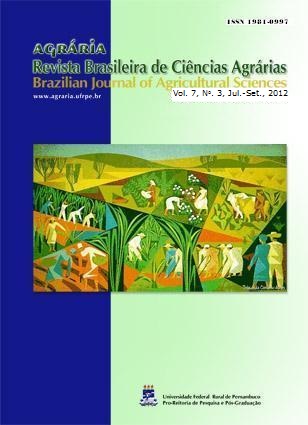Growth of onion irrigated with saline water in soils of semiarid Pernambuco
DOI:
https://doi.org/10.5039/agraria.v7i3a1552Keywords:
Allium cepa, salt stress, salinity, sodicityAbstract
In Irrigated Perimeter Cachoeira II, Serra Talhada - PE, Brazil, it is common to use water with high content of salts in irrigation, which compromises agricultural production. To assess the development of onion at different stages of its cycle, two FLUVIC ENTISOLS irrigated with water of EC 200, 700 and 2000 µScm-1 and SAR 0.5, 10, 15, 20 and 25 (mmol L-1)0,5 were used. After transplanting the seedlings of onion were irrigated with the respective saline
waters. Every thirty days after the transplant one plant was collected for evaluation of growth variables. At thirty and sixty days of development of the onion, it was observed that only the irrigation water of EC 2000 µScm-1 exerted a negative effect on most growth parameters of onion, while at ninety days there were significant reductions in variables with increasing salinity of irrigation water. Among the soils, the sandy loam exercised more negative effect on the growth variables, especially at 30 and 60 days. Thus, the use of saline water with time tends to affect the onion at the end of its cycle, and the fine textured soil tends to be more detrimental under continued use of these waters.



